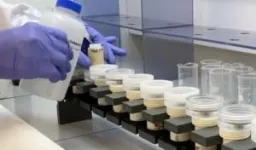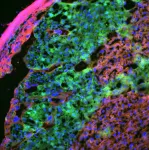(Press-News.org) American Geophysical Union
Press Release No. 23-27
For Immediate Release
11 July 2023
This press release is available online at: https://news.agu.org/press-release/warmer-weather-makes-venomous-snake-bites-more-likely-especially-in-spring
AGU press contact:
Rebecca Dzombak, news@agu.org, +1 (202) 777-7492 (UTC-4 hours)
Emory University press contact:
Rob Spahr, rob.spahr@emory.edu (UTC-4 hours)
Interview requests should be sent to Rob.
WASHINGTON — Climate change is not only making Georgia hotter but also increasing the likelihood of snake bite, according to a new study. Every degree Celsius of daily temperature increase corresponds with about a 6% increase in snake bites, researchers found. The results are published in GeoHealth, which publishes research investigating the intersection of human and planetary health for a sustainable future.
Snakes are cold-blooded animals, so they are generally more active in warmer weather. And globally, temperatures are rising.
“Venomous snake bites are classified by the World Health Organization (WHO) as a high-priority neglected tropical disease,” said Noah Scovronick, a health and environmental scientist at Emory University who led the new study. Around the world, approximately 5 million people are bitten by snakes every year, and of those up to 138,000 people die, according to the WHO.
“We don’t know much about how weather — meaning short term changes in meteorology — drive human-snake interactions, partly because a lot of dangerous snake bites occur in places that lack good data on causes of morbidity and mortality,” Scovronick said.
Within the United States, Georgia is something of a snake hotspot, with one of the highest snake densities and diversities in the country. The state is home to 17 species of venomous snake, seven of which are dangerous enough to be of medical concern.
Scovronick and his colleagues analyzed statewide hospital data from 2014 to 2020, during which time there were 3,908 hospital visits due to venomous snake bites. They statistically compared hospitalizations to daily weather records, searching for strong associations between factors such as minimum and maximum air temperature, precipitation and humidity and snake bites. In their analysis, the researchers controlled for both the month and day of the week the bite occurred, which accounts at least partially for variability in human activity.
The occurrence of venomous snake bites was associated with increased maximum daily air temperatures, the researchers found. While summers had the highest numbers of snake bites, spring had the strongest association between temperatures and snake bites.
Scovronick speculated that the spring association could be because snakes “wake up” during that season, becoming more active and reproducing, while summer days could reach temperatures warm enough to slow snakes down. But that needs further exploration with species-level detail, he said. Other meteorological factors, such as humidity, had weaker or no associations with the rate of venomous snake bites.
The study did not include predictions for how snake bites could change in the future, and Scovronick emphasized the need to carry out similar studies in other states to get a nationwide picture of risk. “We can learn a lot about snake bite patterns even with fairly modest data and using established epidemiological methods,” he said. “This study demonstrates that.”
Just because Georgia is getting warmer doesn’t necessarily mean more people will be hospitalized because of venomous snake bites.
“The key factor to reducing negative encounters is education,” said Lawrence Wilson, a herpetologist at Emory University who was a co-author of the study. “Let people know what habitats snakes favor, such as places with dense groundcover, and they can be wary of such habitats. Snakes and people can live compatibly, even venomous snakes, as long as we respect and understand their habitats and needs.”
But between climate change heating up the state and urban areas expanding, the odds of people encountering snakes are already increasing, according to Wilson.
“As human development in Georgia and especially the Atlanta area are expanding rapidly, human-snake encounters are going to continue to increase and already have,” Wilson said. “Almost anyone who spends a lot of time outdoors will have encountered a copperhead or other venomous snake.”
The specific findings only relate to Georgia, but they highlight a pressing need for similar studies to be done in other parts of the world with different climate regimes and snake species, Scovronick said.
#
Notes for journalists:
This study is published in GeoHealth, a fully open-access journal. View and download a pdf of the study here.
Paper title:
“The association between ambient temperature and snakebite in Georgia, USA: a case-crossover study”
Authors:
Mariah Landry, Stefanie Ebelt, Noah Scovronick (corresponding author), Gangarosa Department of Environmental Health, Rollins School of Public Health, Emory University, GA, USA
Rohan D’Souza, Shannon Moss, Howard H. Chang, Department of Biostatistics and Bioinformatics, Rollins School of Public Health, Emory University, GA, USA
Lawrence Wilson, Department of Biology, Emory University, GA, USA END
Warmer weather makes venomous snake bites more likely, especially in spring
In Georgia, a snake hotspot in the United States, for each degree a day heats up, the odds of getting bitten by a venomous snake increase by nearly 6%. Similar trends may be true elsewhere
2023-07-11
ELSE PRESS RELEASES FROM THIS DATE:
Aston University researcher turns one of the basic rules of construction upside down
2023-07-11
1675 theory states a hanging chain mirrors shape of an upstanding rigid arch
Research from Aston University shows that this common-held belief is incorrect
Explained using transition from Newtonian to Lagrangian mechanics and mathematical rigour.
Monday 10 July 2023 | Birmingham, UK
An Aston University researcher has turned one of the basic rules of construction on its head.
For centuries a hanging chain has been used as an example to explain how masonry arches stand.
Structural engineers are familiar ...
Software creates entirely new views from existing video
2023-07-11
ITHACA, N.Y. -- Filmmakers may soon be able to stabilize shaky video, change viewpoints and create freeze-frame, zoom and slow-motion effects – without shooting any new footage – thanks to an algorithm developed by researchers at Cornell University and Google Research.
The software, called DynIBar, synthesizes new views using pixel information from the original video, and even works with moving objects and unstable camerawork. The work is a major advance over previous efforts, which ...
Working to make steel greener, cleaner
2023-07-11
CLEVELAND–Case Western Reserve University chemical engineer Rohan Akolkar is leading a research team working to develop a new zero-carbon, electrochemical process to produce iron metal from ore.
If successful, the project could be a first step toward eliminating harmful greenhouse gas emissions by eventually replacing century-old, blast-furnace ironmaking with a new electrolytic-iron production process.
Reducing iron ore to metal is carbon- and energy-intensive, leading to significant carbon-dioxide emissions that drive global warming.
“We don’t use carbon at all in our process, so ...
Crawford Lake chosen as the primary marker to identify the start of the Anthropocene epoch
2023-07-11
EMBARGOED: Not for Release Until 18:00 BST 11 July 2023.
Crawford Lake chosen as the primary marker to identify the start of the Anthropocene epoch
Anthropocene proposes human activity has become a dominant influence on the planet, especially since the mid-twentieth century
Nuclear bomb tests have left a ‘stark plutonium fingerprint’ of this change in human activity
Evidence from Crawford Lake in Canada and 12 secondary locations will be assessed by International Commission on Stratigraphy to decide if we have entered a new geological era
Today [11 July 2023] an international team of researchers has chosen the location ...
New study finds U.S. military veterans living in discriminatory ‘redlined’ areas suffered higher rates of cardiovascular disease
2023-07-11
CLEVELAND—U.S. military veterans who lived in what were once known as “redlined” areas had a higher risk for heart attacks and other cardiovascular issues, according to a new study by researchers at Case Western Reserve University, University Hospitals and the Cleveland VA Medical Center.
In the 1930s, the federal government-sponsored Homeowners’ Loan Corp. (HOLC) established maps of U.S. neighborhoods that identified levels of mortgage risk. This practice led to disinvestments and segregation in “redlined” neighborhoods.
Judicial rulings--and, later, federal legislation--prohibited such government practices, but research has shown their ...
$1.5 million donation supports research on effects of psychedelic DMT on the brain
2023-07-11
One of the most powerful psychedelics known, N,N-dimethyltryptamine (DMT) has been described as causing imaginative visuals akin to the dream state. It is typically consumed on its own or in ayahuasca, a ceremonial brew that has been used for spiritual and visionary purposes by indigenous cultures for centuries. Some have expressed that DMT helped address psychological ailments such as depression and addiction, promoting emotional well-being. However, the way that DMT impacts the brain, body and health is largely unknown.
A ...
Carbon taxes that focus on luxury consumption are fairer than those that tax all emissions equally
2023-07-11
Not all carbon emissions are made for the same reason—they range from more essential purposes like heating a home to nonessential “luxury” activities like leisure travel. However, proposals for the implementations of carbon taxes tend to apply to all emissions at an equal rate. This can give rise to and exacerbate inequalities. A new analysis published on July 11 in the journal One Earth suggests taxing luxury carbon emissions at a higher rate instead; if all 88 countries analyzed in this study adopted the luxury-focused policy, this would achieve 75% of the emissions reduction needed to reach the Paris Agreement’s goal of limiting climate change ...
Thermal cloak passively keeps electric vehicles cool in the summer and warm in the winter
2023-07-11
When an electric vehicle is parked outside, its temperature can swing wildly from day to night and season to season, which can lead to deterioration of the battery. To dampen these fluctuations and extend the battery’s lifespan, researchers have designed an all-season thermal cloak that can cool an electric vehicle by 8°C on a hot day and warm it by 6.8°C at night. The cloak, made predominantly of silica and aluminum, can do so passively without outside energy input and operates without any modification between hot or cold weather. This prototype is described July 11 in the newly launched Device, an application-oriented sister journal ...
Breaking into tears with microrheology to design custom eye drops
2023-07-11
WASHINGTON, July 11, 2023 – Compared to artificial tears, or eye drops, human tears are significantly more complex liquids, with a wide range of components including lipids, carbohydrates, proteins, water, and salt. It is this complex mixture that gives tears the perfect thickness and ability to moisturize the eye, a design that is hard to replicate with fewer ingredients.
In Physics of Fluids, from AIP Publishing, Vega et al. researched human tears at the micron level to reveal new ways of customizing artificial tears to address individual symptoms of dry eye disease. The detailed insights they gained about the composition and behavior ...
Unborn babies use ‘greedy’ gene from dads to ‘remote-control’ mums into feeding them extra food
2023-07-11
Unborn babies use ‘greedy’ gene from dads to ‘remote-control’ mums into feeding them extra food
Fetuses use a copy of a gene inherited from their dad to force their mum to release as much nutrients as possible during pregnancy, Cambridge scientists have discovered.
The unborn baby ‘remote controls’ its mother’s metabolism so the two are in a nutritional tug of war. The mother’s body wants the baby to survive but needs to keep enough glucose and fats circulating in her system for her own health, to be able to deliver ...
LAST 30 PRESS RELEASES:
New technique lights up where drugs go in the body, cell by cell
New study finds movement of fishing fleets can reveal shifts in marine ecosystems
Embargoed: New evidence points to potential treatment for vascular dementia
Study uncovers disrupted brain balance in alcohol dependence
Working in groups can help Republicans and Democrats agree on controversial content moderation online
Structural findings reveal how distinct GPCR ligands create different levels of activation
Anything-goes “anyons” may be at the root of surprising quantum experiments
UC review: Maximizing workplace opportunity for veterans
From generation to complex control: Metasurfaces make perfect vortex beams "within reach"
Thin-film lithium niobate-based detector: recent advances and perspectives
Exploring why some people may tend to persistently make bad choices
How cells balance their protein levels
Nirsevimab vs RSVpreF vaccine for RSV–related hospitalization in newborns
Effectiveness and impact of maternal RSV immunization and nirsevimab on medically attended RSV in US children
AI gives scientists a boost, but at the cost of too many mediocre papers
Next-generation vision model maps tree growth at sub-meter precision
Genes aren’t destiny for inherited blindness, study shows
MIT study: High-fat diets make liver cells more likely to become cancerous
Exposure to multiple fine particulate matter components and incident depression in the US Medicare population
Risk of burdensome health care spending over time in the US
Nirsevimab against hospitalizations and emergency department visits for lower respiratory tract infection in infants
New microfluidics technology enables highly uniform DNA condensate formation
A new strategy for immune tolerance
Super Mario Bros. help fight burnout: New study links classic games to boosted happiness
Deepest gas hydrate cold seep ever discovered in the arctic: International research team unveils Freya Hydrate Mounds at 3,640 m depth.
Integrating light and structure: Smarter mapping for fragile wetland ecosystems
ACA-SIM: A robust way to decode satellite signals over complex waters
Probiotics can restore gut microbiome in breastfed infants
AI could help predict nutrition risks in ICU patients, study finds
Federal EITC has unexpected result, researchers say – it decreases domestic violence
[Press-News.org] Warmer weather makes venomous snake bites more likely, especially in springIn Georgia, a snake hotspot in the United States, for each degree a day heats up, the odds of getting bitten by a venomous snake increase by nearly 6%. Similar trends may be true elsewhere










